Which Way Should a Fan Spin in Summer in Australia? Cooling Tips for Hot Days
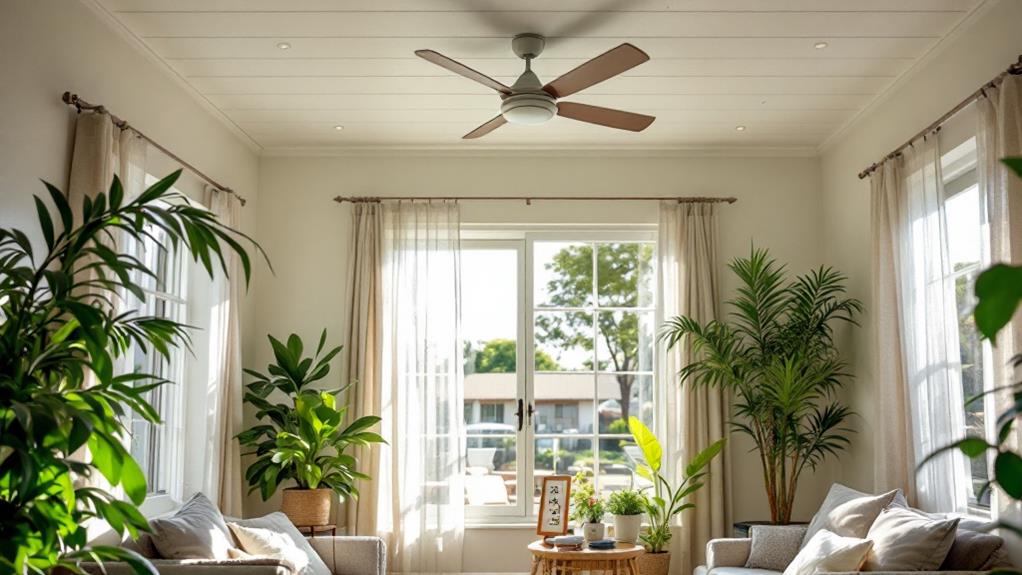
Make certain your fan spins counterclockwise during the Australian summer for maximum cooling. This creates a cooling downdraft, making your room feel up to 8 degrees cooler by improving the wind chill effect and promoting better evaporation from your skin. To check, stand beneath the fan and feel for a cool breeze; if not, adjust the direction easily with the reversing switch or remote. Utilizing your fan correctly allows you to raise the thermostat setting without sacrificing comfort, saving energy and reducing costs. Investigate further to find out how these strategies can improve your home's energy efficiency and comfort.
Importance of Fan Direction
Understanding the importance of fan direction can vastly improve your home's comfort and energy efficiency. By setting your ceiling fan to the correct summer mode, you can boost your home's cooling without relying solely on your air conditioning. The ideal ceiling fan direction in the summer is counterclockwise. This setting creates a downdraft, producing a revitalizing breeze that makes the room feel cooler and more comfortable during hot weather.
When you adjust your ceiling fan to spin counterclockwise, you can raise your thermostat by up to 4 degrees without losing comfort. This simple change leads to significant energy savings, reducing your cooling costs by up to $38 a month when used alongside your air conditioning system.
Additionally, correct fan direction contributes to improved HVAC efficiency. When your ceiling fan works in harmony with your air conditioning, it reduces the workload on your HVAC system, helping it operate more efficiently and potentially extending its lifespan.
Summer Fan Rotation Explained
To get the most out of your ceiling fan during the summer, make sure it spins counterclockwise. This ceiling fan's direction is vital for creating a downdraft, which generates a cooling breeze that improves comfort on hot days. The counterclockwise rotation not only increases the airflow but also enhances evaporation from your skin. This process results in a wind chill effect that can make the room feel up to 8 degrees cooler, allowing you to stay comfortable even as temperatures rise.
By setting your fan blades at a minimum angle of 12 degrees, you optimize airflow and cooling efficiency. This setup enables the fan to maximize its performance, providing a pleasant breeze that helps keep the heat at bay. As a result, you can raise your thermostat settings by up to 4 degrees without sacrificing comfort, greatly reducing your reliance on air conditioning and saving energy.
Remember to regularly check and adjust the fan direction at the beginning of the summer season. Ensuring your ceiling fan spins in the right direction guarantees you'll enjoy its full cooling benefits, helping you stay cool and comfortable all summer long.
Identifying Proper Spin
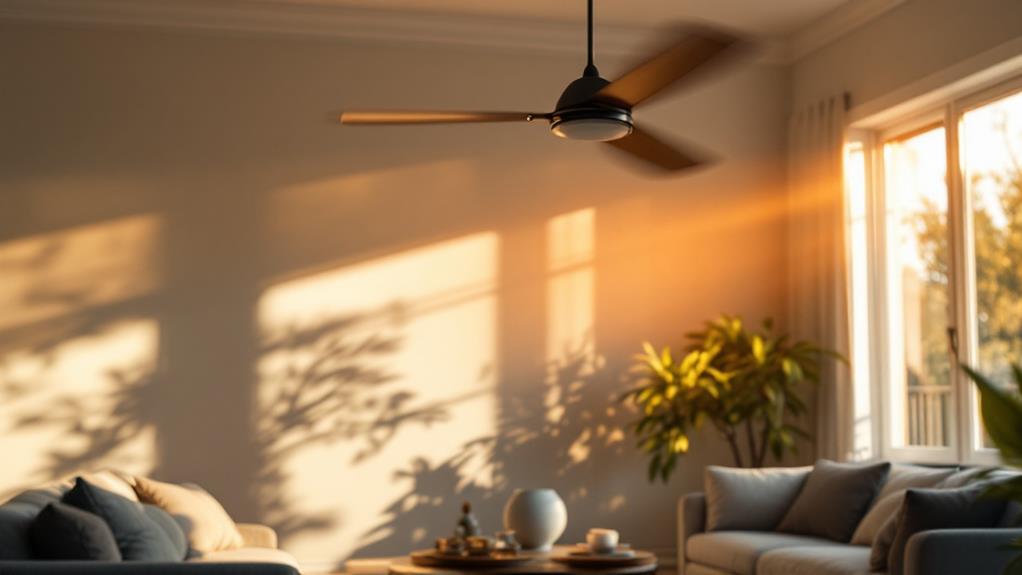
Knowing your ceiling fan spins counterclockwise in the summer is key to optimizing its cooling benefits. The counterclockwise direction creates a cooling downdraft, enhancing airflow and guaranteeing you feel comfortable on hot days. To identify if your fan is spinning correctly, stand directly beneath it while it's operating. If you feel a cool air breeze, your fan is in the right summer mode.
However, if there's little to no airflow, your fan might be spinning clockwise, which is typically a winter setting. In this case, you'll need to switch the direction to counterclockwise. Many ceiling fans have a reversing switch on the motor, while others might allow you to change the spin direction using a remote control. Adjusting this setting will help assure that you're maximizing your fan's efficiency during the hotter months.
Adjusting Fan Settings
How can you guarantee your ceiling fan is set for ideal cooling this summer? Start by confirming it spins counterclockwise. This direction creates a revitalizing downdraft that improves air moving throughout the room. Locate the reverse switch on your fan's body to adjust the direction. Simply move it to the summer position before turning the fan back on. For those with remote-controlled fans, verify the fan is completely off. Press and hold the fan button on the remote until the light blinks, indicating the direction has changed to counterclockwise.
To optimize airflow efficiency, regularly check and clean the fan blades. Dust buildup can greatly hinder performance and cooling effectiveness. If you're using multiple fans in larger spaces, pay attention to the blade angle and pitch. A minimum blade angle of 12 degrees is recommended for effective cooling. This guarantees enough air is being circulated to keep you comfortable on hot days.
Benefits of Correct Usage

Verifying your ceiling fan spins counterclockwise is just the start; using it correctly brings significant benefits. By setting your ceiling fan to spin counterclockwise during the summer, you create a cooling downdraft that can make a room feel up to 4 degrees cooler. This is due to the wind chill effect, which improves skin evaporation. You'll feel more comfortable, even on the hottest days.
Proper usage of your ceiling fan can also help you cut back on air conditioning. By relying less on AC, you might save up to $38 in cooling costs each month. This means more money in your pocket and less strain on your AC unit. Furthermore, with a ceiling fan, you can set your thermostat higher without sacrificing comfort, leading to reduced energy consumption and lower electricity bills.
For best performance, regularly adjust the fan's direction and keep the blades clean to maintain efficient airflow. This practice guarantees you optimize the fan's cooling potential. Improved air circulation is particularly beneficial in larger rooms, helping to maintain consistent temperatures and minimize hot spots. Enjoy a cooler, more comfortable space without overworking your air conditioning system.
Energy Efficiency Tips
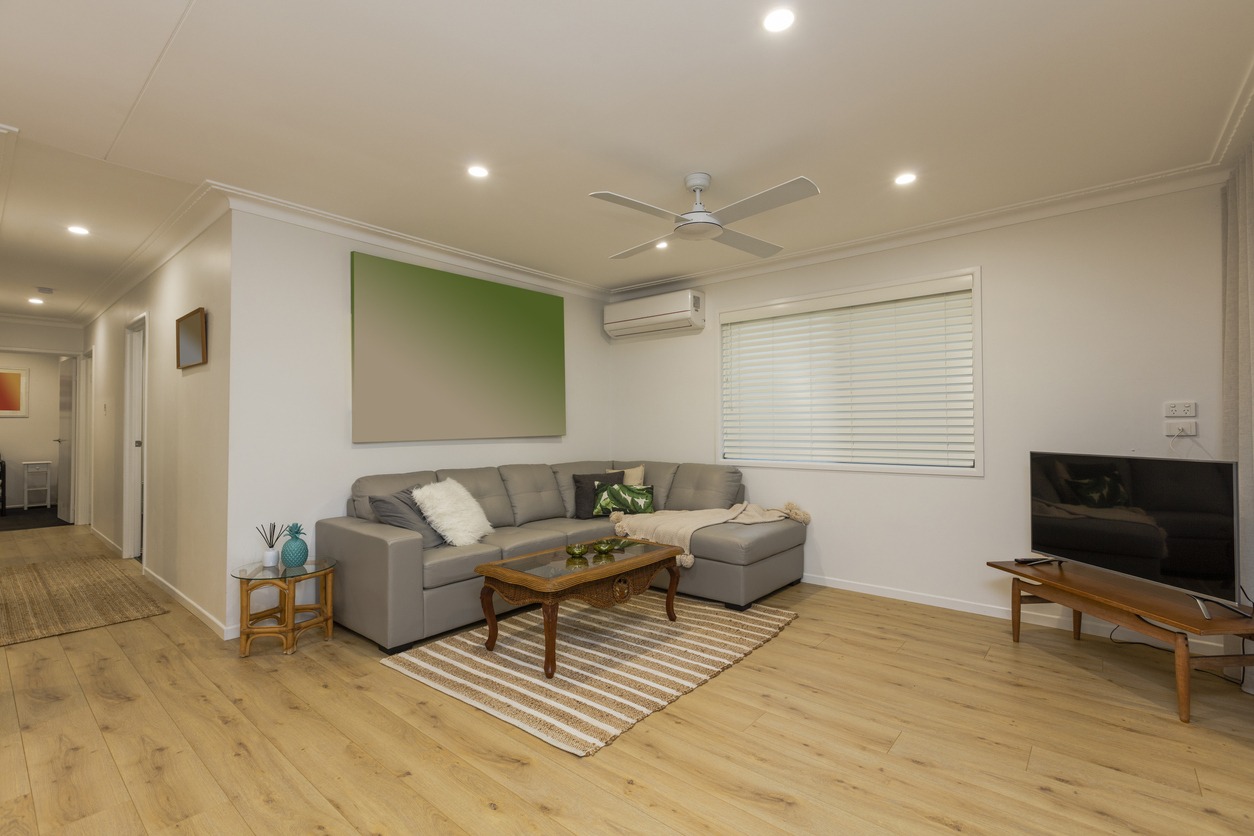
To improve energy efficiency during summer, make sure your ceiling fan spins counterclockwise. This direction creates a cooling downdraft, making you feel up to 8 degrees cooler. With your ceiling fan running correctly, you can raise your thermostat by up to 4 degrees. This adjustment leads to significant energy savings on cooling costs, as fans consume considerably less power—around 50 watts compared to 3,500 watts for high-efficiency air conditioning units.
Switching your fan's reverse function as seasons change is essential. In winter, the ceiling fan should go clockwise to circulate warm air trapped near the ceiling. This regular adjustment can improve your HVAC system's general efficiency, potentially saving you up to $38 monthly on cooling expenses during the hot months. Ensuring the fan blades maintain a minimum angle of 12 degrees is also important for maximizing airflow and increasing cooling efficiency during summer.
Fan and Air Conditioning
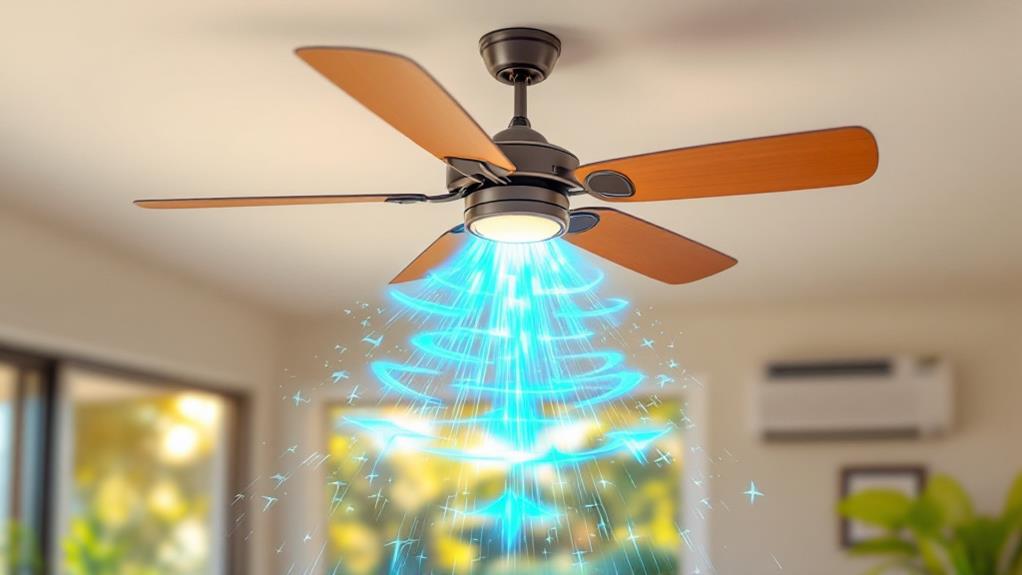
Combining ceiling fans with air conditioning can create a powerful cooling duo that improves comfort while minimizing energy costs. By running your ceiling fan in a counterclockwise direction during summer, you can harness the wind chill effect, which helps your body feel cooler by facilitating perspiration evaporation. This allows you to raise your air conditioning thermostat setting while maintaining comfort, potentially cutting cooling costs by up to 4 degrees.
Here's how you can optimize cooling efficiency:
- Direction Matters: Confirm your ceiling fan spins counterclockwise in summer to utilize the wind chill effect effectively.
- Higher Thermostat Settings: Increase your air conditioning thermostat by a few degrees when using a fan. This small adjustment can lead to significant energy savings.
- Choose ENERGY STAR: Opt for ENERGY STAR-rated ceiling fans. These fans use 8% less energy than standard models, improving your overall energy efficiency.
- Size and Placement: In large rooms over 500 sq. ft., consider installing multiple fans to optimize airflow and support your air conditioning system efficiently.
Common Mistakes to Avoid
While combining ceiling fans with air conditioning can improve cooling, avoiding common mistakes is likewise essential to maintain efficiency and comfort. One common mistake is letting your ceiling fan go in the wrong direction. In the summer, make sure your ceiling fan blades spin counterclockwise. This creates a cooling downdraft that makes the room feel cooler, allowing you to reduce your reliance on the air conditioner.
Another mistake is forgetting to adjust your fan settings with the seasons. Check the switch on the fan's motor to verify it's set correctly. This small adjustment can notably improve your fan's efficiency and save on energy costs. Also, inspect the angle of your fan blades. They should have a minimum angle of 12 degrees for ideal airflow. If the angle is too shallow, the fan won't circulate air effectively.
Neglecting to clean fan blades is also a common oversight. Dust and dirt can accumulate, obstructing airflow and reducing performance. Regular cleaning will keep your fan operating at its best. By avoiding these pitfalls, you'll improve your ceiling fan's efficiency and enjoy a cooler, more comfortable space without overworking your air conditioner.
Testing Fan Effectiveness
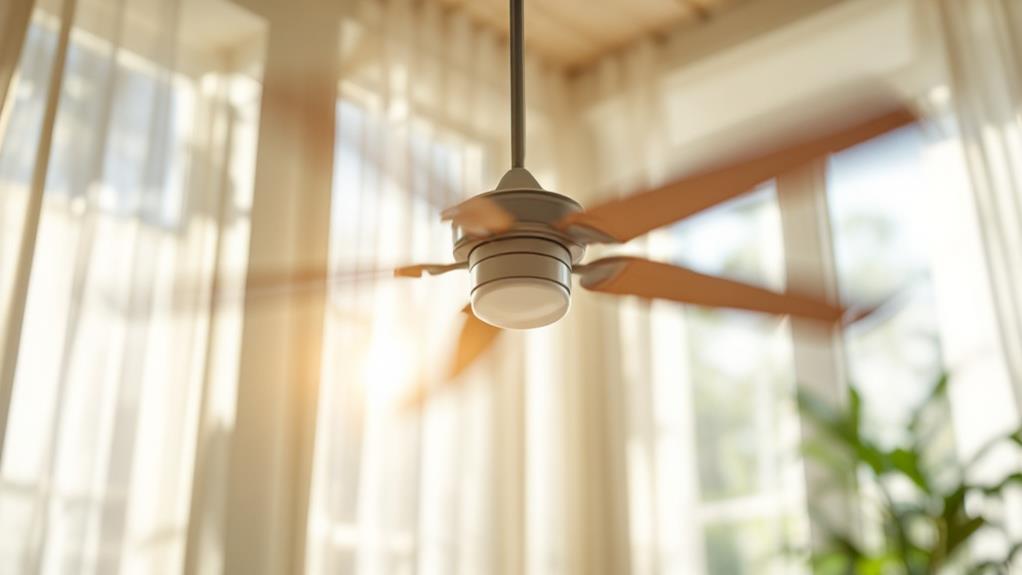
One simple way to test your ceiling fan's effectiveness during summer is by standing directly underneath it while it's running. You should feel a noticeable cool breeze, indicating that the fan is spinning counterclockwise. This direction is essential as it helps in pushing the air down, enhancing the cooling effect. If you feel little to no airflow, your fan might be spinning clockwise, which isn't ideal for cooling. Here's a quick checklist to verify your fan's peak performance:
- Check the Blade Angle: Confirm your fan blades have at least a 12-degree angle to optimize airflow and cooling efficiency.
- Use Remote Control: If your fan has one, use the remote control to switch to counterclockwise direction without manually adjusting it.
- Inspect and Clean: Regularly clean the fan blades to remove dust and debris. Clean blades improve airflow and general effectiveness.
- Verify the Spin Direction: Look up at the fan to confirm it's spinning counterclockwise. If not, switch it using the fan's settings or remote control.
Seasonal Maintenance Guide
Proper seasonal maintenance of your ceiling fan guarantees it operates efficiently throughout the summer months. Start by verifying your ceiling fan spins counterclockwise. This direction creates a cooling downdraft, enhancing the airflow efficiency and providing a significant cooling effect on those sweltering days. At the beginning of each summer, check and adjust the fan's direction to make certain it's set correctly for peak performance.
Next, focus on keeping your fan blades clean. Dust buildup can hinder airflow efficiency, reducing the cooling effect you need. Regularly dusting and wiping down the blades can prevent this and help your fan work at its best.
Additionally, consider the appropriate fan speed for the size of your room. Larger spaces may require higher fan speeds to maintain a comfortable temperature, while smaller rooms might achieve the desired cooling with lower speeds. Adjusting the fan speed can guarantee you're getting the most out of your ceiling fan.
Lastly, combine your ceiling fan with air conditioning. This duo can help you save energy, allowing you to raise your thermostat setting by up to 4 degrees without sacrificing comfort. Following these seasonal maintenance steps guarantees your fan is ready to keep you cool all summer long.




